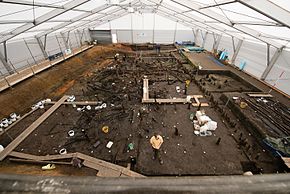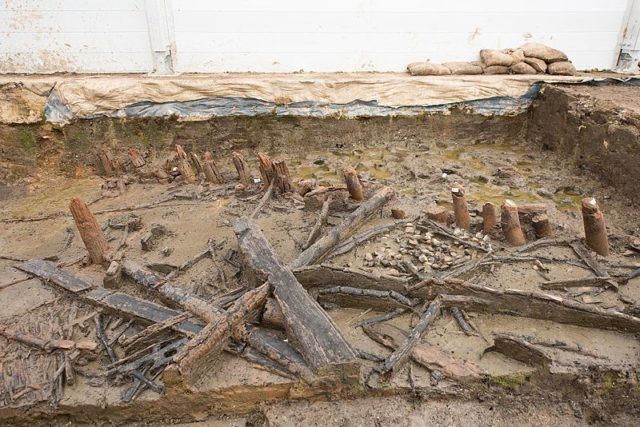The marshy swampland and waterways that connect Cambridgeshire were once home to a wealthy Bronze Age community. It is being referred to as the “Pompeii of the Fens” by archaeologists.
The community was destroyed in a fire around 1,000 BC and descended beneath the water into the dense mud. A 10-month dig at the site has revealed extraordinary details of what life was like in Bronze Age Britain nearly 3,000 years ago.

Discoveries at the site give an idea of daily life, including how houses were created, what household goods the occupants had, what they ate, and how their clothes were made. But the findings also suggest the community imported goods from Europe and the Middle East. Archaeologists have spent the ten months excavating at least five ancient spherical wooden houses which had been built on lifters in the East Anglian fens.
The team working at Must Farm at Whittlesey in Cambridgeshire has revealed a collection of Bronze Age materials and one of the largest collections of Bronze Age glass ever found in Britain. The Pompeii of the Fens at Cambridgeshire is the best-preserved ancient settlement ever excavated in Britain and is thought to have been demolished by a major fire which caused the dwellings to collapse into a river.
However, the river represented a valuable way of preserving many of the artifacts which would otherwise have been ruined by the fire. Evidence, including tree-ring examination of oaks, proposes that at the time of the fire the structures were still fresh and had only been occupied for a few months, regardless of how well-equipped they were.
Duncan Wilson, chief supervisor of Historic England, who joint-funded the archaeological site, remarked that “over the past 10 months, Must Farm has given us an extraordinary window into how people lived 3,000 years ago. Finally, archaeologists understand this small but wealthy city’s diet, how their city was built, and the dynamics of the marketplace. This crucial revelation has transformed our knowledge of Britain during the Bronze Age. More discoveries will soon come to light as the excavation enters its preservation and research phase. At least five houses were discovered at the Must Farm village; all built very close together in a small community of people that resembles modern day suburbia.

Every home had been built to match the same style of living. This included a storage area for meats and a kitchen that was used to make breakfast, lunch, and dinner. These roundhouses were created on stilts located above a small river. They included conical roofing constructed as thick wooden rafters protected with clay turf in the thatch. The walls and floors were created from wickerwork. Inside of these homes, archaeologists discovered households goods including complete pottery sets, platters, decorative artwork, wooden buckets, and even tweezers. Some of the pottery was even discovered to have food left inside of it, probably due to the fact that the homeowners left suddenly as the small settlement started to burn.
Shockingly, archaeologists uncovered a true human characteristic – even though the houses were designed the same throughout the settlement, each residence had unique assets; this suggests that this small settlement was founded by businessmen and tradesmen. Further, it appears that the townsmen carried decorative glass beads from the Mediterranean Basin and amber from the Middle East. Most of the remains in the small settlement were in a brand new condition, leaving traces of the age of the settlement. The barely untouched objects suggest the settlement was practically new before it burnt to the ground.
The textiles that were discovered turned out to be rare, even though such items were known to have been common during the Bronze Age. To the delight of the excavators, they unearthed a variety of textiles that included twine, plants, and even loom weights that had been used by knitters while they were weaving their threads.
The findings also gave archaeologists insight into what people ate in the Bronze Age. The settlement was thought to have good hunters because the remains show the settlement was blessed with wild boar, red deer, and freshly caught pike. Additionally, the remains of baby lambs and little calves were found, providing a snapshot of luxury in the little settlement. Porridge was even found incredibly preserved inside of bowls.
This excavation of the well-preserved site has finally come to a halt, but the discoveries found in this small settlement may very well spur public interest in the future.
